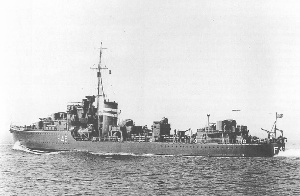
HMS Juno was a J-class destroyer of the Royal Navy laid down by the Fairfield Shipbuilding and Engineering Company, Limited, at Govan in Scotland on 5 October 1937, launched on 8 December 1938 and commissioned on 25 August 1939. Juno participated in the Battle of Calabria in July 1940 and the Battle of Cape Matapan in March 1941.

HMS Corunna (D97) was a later or 1943 Battle-class fleet destroyer of the Royal Navy. She was named in honour of the Battle of Corunna, which took place during the Peninsular War in 1809 between British and French forces. Corunna was built by Swan Hunter & Wigham Richardson Limited on the Tyne. She was launched on 29 May 1945 and commissioned on 6 June 1947.
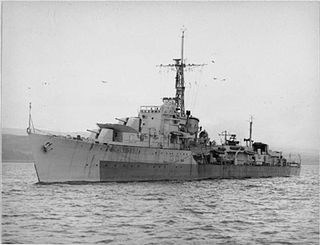
HMS Zebra was a Z-class destroyer. She was to have been named HMS Wakeful but was renamed in January 1943 before launching. The destroyer was launched on 18 March 1944 at William Denny & Brothers shipyard in Dumbarton, Scotland and commissioned on 13 October 1944. She was 'adopted' by the civil community of Urmston, then in the county of Lancashire.

HMS Berkeley Castle was a Castle-class corvette of the United Kingdom's Royal Navy. Built and commissioned in 1943, she escorted convoys from 1944 to 1945. She later served as an air-sea rescue ship until being placed in reserve. Damaged beyond repair in the North Sea flood of 1953 while at a dry dock in Sheerness, she was scrapped a few years later. She was named after Berkeley Castle in Gloucestershire.

ORP Piorun was an N-class destroyer operated by the Polish Navy in World War II. The word piorun is Polish for "Thunderbolt". Ordered by the Royal Navy in 1939, the ship was laid down as HMS Nerissa before being loaned to the Poles in October 1940 while still under construction.

HMS Grenville was the second ship of this name to serve with the Royal Navy in the Second World War. Grenville and seven other U-class destroyers were ordered as part of the Emergency Programme. She was launched at Swan Hunter and Wigham Richardson Ltd., Wallsend-on-Tyne on 12 October 1942 and commissioned on 27 May 1943.

HMS Ulster was a U-class destroyer of the Royal Navy of the United Kingdom that saw service during World War II. She was later converted into a Type 15 fast anti-submarine frigate, with the new pennant number F83. Ulster was the second vessel in Royal Navy history to have that name.
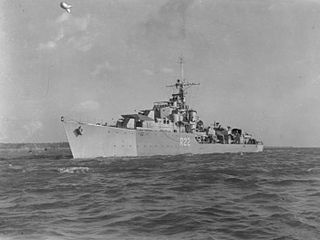
HMS Ursa was a U-class destroyer of the Royal Navy that saw service during the Second World War. She was later converted into a Type 15 fast anti-submarine frigate, with the new pennant number F200.

The second HMS Whirlwind was a W-class destroyer of the British Royal Navy and was built by Hawthorn Leslie and was launched on 30 August 1943. She saw service during World War II and the Cold War.

HMS Zetland was a Royal Navy Type II Hunt-class destroyer, named after the Zetland Hunt.

HMS Chiddingfold (L31) was a Type II Hunt-class destroyer of the Royal Navy. She was leased to the Indian Navy in 1952 where she served as INS Ganga (D94).

HMS Alacrity was a modified Black Swan-class sloop of the Royal Navy. She was built for service as a convoy escort during the Second World War, but was completed too late to see action. She did subsequently take part in the Korean War between 1950 and 1952. She was scrapped in 1956.

HMS Oakham Castle was a Royal Navy corvette of the Castle class. Built as a convoy escort during the Second World War, it later became a weather ship before being scrapped in 1977.

HMS Torrid was an R-class destroyer which served with the Royal Navy during World War I. The ship was launched on 10 February 1917 and served as part of the Harwich Force. Subsequently, Torrid was used in the 1930s as a trials ship for new anti-submarine warfare weapons, particularly playing a role in the development of ASDIC. During this time, the destroyer was commanded by Charles Pizey, later the first Chief of the Naval Staff of the Indian Navy. The vessel was wrecked off the Falmouth coast en route to being broken up on 16 March 1937.
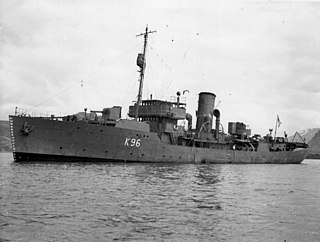
HMS Aubrietia (K96) was a Flower-class corvette built for the Royal Navy (RN) from 1941-1946. She was active as a convoy escort in the Atlantic and Mediterranean. In May 1941, Aubrietia sighted and depth charged the German submarine U-110, leading to its capture and the seizure of a German Naval Enigma and its Kurzsignale code book.

HMS Swift was an S-class destroyer built for the Royal Navy in the Second World War. The ship belonged to the January 1941 order of the Royal Navy from the War Emergency program. The destroyer was launched from the shipyard J. Samuel White in Cowes on 15 June 1943 and was put into service on 12 December 1943.
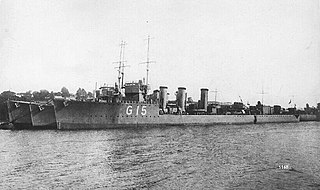
HMS Rowena was an R-class destroyer which served with the Royal Navy during World War I. Launched on 1 July 1916, the ship operated as part of the Grand Fleet as part of a destroyer flotilla hunting for German vessels that were attacking convoys in the North Sea. Although there were many reported sightings, no submarines were sunk. After the conflict, the vessel was transferred to the Navy’s establishment at Portland to help in the development of anti-submarine warfare, which ultimately helped in the Battle of the Atlantic. Rowena did not, however, see the fruit of this labour. After twenty years of service, the destroyer was retired and sold to be broken up on 27 January 1937.

HMS Romola was an R-class destroyer which served with the Royal Navy during World War I. Launched on 14 May 1916, the ship operated as part of the Grand Fleet, operating as part of a destroyer flotilla. The ship sailed to intercept the German High Seas Fleet in what would be one of the last major expeditions of their Navy in the war but saw no action. After the conflict, the destroyer was held in reserve until being retired and sold to be broken up on 13 March 1930.

HMS Poppy was a Flower-class corvette that served in the Royal Navy as a convoy escort during World War II.

HMS Amaranthus (K17) was a Flower-class corvette of the Royal Navy. She took part in the Second World War, being involved in escorting convoys from West Africa to the United Kingdom from May 1941 onwards.



















